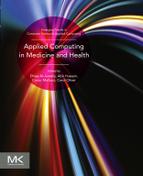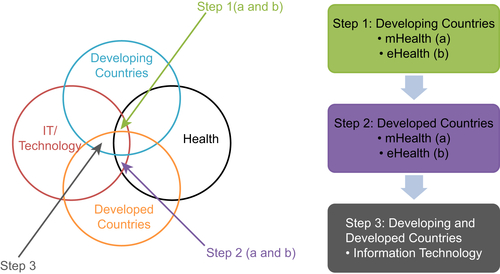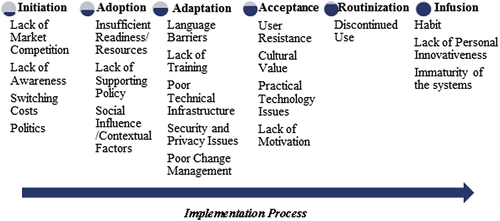[1] Scheepers H, Scheepers R. The Implementation of Mobile Technology in Organizations: Expanding Individual Use Contexts. ICIS. 2004.
[2] Varshney U. Mobile health: Four emerging themes of research. Decis Supp Syst. 2014;66:20–35.
[3] Istepanian R.S.H, Jovanov E, Zhang Y.T. Guest Editorial Introduction to the Special Section on M-Health: Beyond Seamless Mobility and Global Wireless Health-Care Connectivity. IEEE Trans Inform Technol Biomed. 2004;8:405–414.
[4] Burley L, Scheepers H, Fisher J. Diffusion of Mobile Technology in Healthcare. In: Proceedings of the Euro mGOV First European Mobile Government Conference. Brighton, UK. 2005.
[5] XU W, LIU Y. mHealthApps: A Repository and Database of Mobile Health Apps. JMIR Mhealth Uhealth. 2015;3:e28.
[6] Nhavoto J.A, Grönlund A. Mobile Technologies and Geographic Information Systems to Improve Health Care Systems: A Literature Review. JMIR mhealth uhealth. 2014;2:e21.
[7] Kahn J.G, Yang J.S, Kahn J.S. “Mobile” Health Needs and Opportunities in Developing Countries. Health Aff. 2010;29:252–258.
[8] Chib A, van Velthover M.H, Car J. mHealth Adoption In Low-Resource Environments: A Review of the Use of Mobile Healthcare In Developing Countries. J Health Commun. 2014:1–53.
[9] Lyytinen K, Hirschheim R. Information Systems Failures: A Survey and Classification of the Empirical Literature. Oxford: Oxford Surveys in Information Technology, Oxford University Press; 1987 p. 257–309.
[10] Kwon T.H, Zmud R. Unifying the Fragmented Models of Information Systems Implementation. In: Boland R.J, Hirschheim R, eds. Critical Issues in Information Systems Research. New York: John Wiley and Sons; 1987:227–251.
[11] Prescott M.B, Conger S.A. Information Technology Innovations: A Classification by IT Locus of Impact and Research Approach. ACM SIGMIS Database. 1995;26:20–41.
[12] Cooper R.B, Zmud R. Information Technology Implementation Research: A Technological Diffusion Approach. Manage Sci. 1990;36:123–139.
[13] Thompson V.A. Bureaucracy and Innovation. Alabama: University of Alabama Press University; 1969.
[14] McFarlan F.W, McKenney J.L. The Information Archipelago-Gaps and Bridges. Harvard Business Rev. 1982;60:109–119.
[15] Sousa R.D, Goodhue G.L. Understanding Exploratory Use of ERP Systems. AMCIS. 2003 Proceedings.
[16] Dewan S, Riggins F.J. The Digital Divide: Current and Future Research Directions. J Assoc Inform Syst. 2005;6:13.
[17] Chib A. The Aceh Besar Midwives with Mobile Phones Project: Design and Evaluation Perspectives Using the Information and Communication Technologies for Healthcare Development Model. J Comput Med Commun. 2010;15:500–525.
[18] Norris A.C, Stockdale R.S, Sharma S. A Strategic Approach to M-Health. Health Inform J. 2009;15:244–253.
[19] Mansfield E, Rapoport J, Romeo A, Villani E, Wagner S, Husic F. The Production and Application of New Industrial Technology. New York: Norton; 1977.
[20] Robertson T.S, Gatignon H. Competitive Effects on Technology Diffusion. J Marketing. 1986;50:1–12.
[21] Funk J.L, Methe D.T. Market- and Committee-Based Mechanisms in the Creation and Diffusion of Global Industry Standards: The Case of Mobile Communication. Res Policy. 2001;30:589–610.
[22] Heeks R. Health Information Systems: Failure, Success and Improvisation. Int J Med Inform. 2006;75:125–137.
[23] Avgerou C. Information systems in developing countries: a critical research review. J Inform Technol. 2008;23:133–146.
[24] Kim H.W, Gupta S. Investigating Customer Resistance to Change in Transaction Relationship with an Internet Vendor. Psychol Market. 2012;29:257–269.
[25] Jones E, Sundaram S, Chin W. Factors Leading to Sales Force Automation Use: A Longitudinal Analysis. J Pers Sell Sales Manage. 2002;22:145–156.
[26] Ziaie P. Challenges and issues of ICT industry in developing countries based on a case study of the barriers and the potential solutions for ICT deployment in Iran. In: International Conference on Computer Applications Technology (ICCAT).IEEE. 2013.
[27] Kalathil S. Dot. Com for Dictators. Foreign Policy. 2003:43–49.
[28] Chib A, Wilkin H, Hoefman B. Vulnerabilities in mHealth implementation: a Ugandan HIV/AIDS SMS campaign. Global Health Prom. 2013;20:26–32.
[29] Goel S, Bhatnagar N, Sharma D, Singh A. Bridging the Human Resource Gap in Primary Health Care Delivery Systems of Developing Countries with mHealth: Narrative Literature Review. JMIR mhealth uhealth. 2013;1:e25.
[30] Medhi I, Jain M, Tewari A, Bhavsar M, Matheke-Fischer M, Cutrell E. Combating rural child malnutrition through inexpensive mobile phones. In: Proceedings of the 7th Nordic Conference on Human-Computer Interaction: Making Sense Through Design. 2012:635–644 ACM.
[31] Matheson A.I, Baseman J.G, Wagner S.H, O’Malley G.E, Puttkammer N.H, Emmanuel E, et al. Implementation and Expansion of an Electronic Medical Record for HIV Care and Treatment in Haiti: An Assessment of System Use and the Impact of Large-Scale Disruptions. Int J Med Inform. 2012;81:244–256.
[32] Scott R.E, Chowdhury M.F, Varghese S. Telehealth policy—looking for global complementarity. J Telemed Telecare. 2002;8:55–57.
[33] Khoja S, Durrani H, Nayani P. Scope of Policy Issues in eHealth: Results from a Structured Literature Review. J Med Internet Res. 2012;14:e34.
[34] Al-Shorbaji N. Panel discussion participation at World Bank Day @ mHealth Summit—Part 3. Washington, DC: Internet; 2009.
[35] Kelman H.C. Compliance, identification, and internalization: Three processes of attitude change. J Conflict Resolution. 1958:51–60.
[36] O’ Connor Y, Treacy S, O’Donoghue J. Examining Contextual Factors and Individual Value Dimensions of Healthcare Providers Intention to Adopt Electronic Health Technologies in Developing Countries. In: IFIP 8.6 Creating Value for All Through IT. Berlin: Springer; 2014:345–354.
[37] Fulk J, Schmitz J, Steinfield C.W. A Social Influence Model of Technology Use. Org Commun Technol. 2001:117.
[38] Gupta B, Dasgupta S, Gupta A. Adoption of ICT in a Government Organization in a Developing Country: An Empirical Study. J Strat Inform Syst. 2008;17:140–154.
[39] McNab C. What social media offers to health professionals and citizens. Bull World Health Org. 2009;87:566.
[40] Deglise C, Suggs S, Odermatt P. Short Message Service (SMS) Applications for Disease Prevention in Developing Countries. J Med Internet Res. 2012;14:e3.
[41] Coloma J, Harris E. From Construction Workers to Architects: Developing Scientific Research Capacity in Low-Income Countries. PLoS Biol. 2009;7:e1000156.
[42] Hafkin N, Taggart N, Gender. Information Technology, and Developing Countries: An Analytic Study. Academy for Educational Development LearnLink for the Office of Women in Development. United States Agency for International Development; 2001. Retrieved July 29, 2014, from: http://pdf.usaid.gov/pdf_docs/PNACM871.pdf.
[43] United Nations Education, Scientific and Cultural Organisation. The Global Literacy Challenge. A profile of youth and adult literacy at the mid-point of the United Nations Literacy Debate;. 2003–2012. Available at: http://unesdoc.unesco.org/images/0016/001631/163170e.pdf.
[44] Leung C.H, Chan Y.Y. Mobile learning: a new paradigm in electronic learning. In: The 3rd IEEE International Conference on Advanced Learning Technologies. 2003:76–80.
[45] Aker J.C, Mbiti I.M. Mobile Phones and Economic Development in Africa. CGD Working Paper 211. Washington, D.C.: Center for Global Development; 2010. Available at: http://www.cgdev.org/content/publications/detail/1424175 (accessed March 1, 2014).
[46] International Telecommunications Union. Study on international Internet connectivity in sub-Saharan Africa. 2013. Available at: http://www.itu.int/en/ITU-D/Regulatory-Market/Documents/IIC_Africa_Final-en.pdf (accessed March 1, 2014).
[47] Blaschke S, Bokenkamp K, Cosmaciuc R, Denby M, Hailu B, Short R. Using mobile phones to improve child nutrition surveillance in Malawi. Brooklyn, NY: UNICEF Malawi, UNICEF Innovations, Mobile Development Solutions; 2009.
[48] Galpottage P.A.B, Norris A. Patient Consent Principles and Guidelines for E-Consent: A New Zealand Perspective. Health Inform J. 2005;11:5–18.
[49] Fitch C.J, Adams C. Managing Mobile Provision for Community Healthcare Support: Issues and Challenges. Business Proc Manage J. 2006;12:299–310.
[50] Luxton D.D, Kayl R.A, Mishkind M.C. mHealth Data Security: The Need For HIPAA-Compliant Standardization. Telemed e-Health. 2012;18:284–288.
[51] Tanzer O. mHealth Applications and Security. HIMSS Europe, World of Health IT Conference (WoHIT), Nice, France. Available at: http://85.236.157.21/∼himss/presentations/0204/RISSO9%202%2003%20PDF/4%20Security%20of%20the%20data%20in%20mhealth/01%20Oguz%20Tanzer/Dr.OguzTanzer-WoHIT_2014_mHealth%20Applications-Security_v8.pdf.
[52] Chang L.W, Kagaayi J, Arem H, Nakigozi G, Ssempijja V, Serwadda D, Quinn T.C, Gray R.H, Bollinger R.C, Reynolds S.J. Impact of a mHealth intervention for peer health workers on AIDS care in rural Uganda: a mixed methods evaluation of a cluster-randomized trial. AIDS Behav. 2011;15:1776–1784.
[53] Paton R.A, McCalman J. Change Management: A Guide To Effective Implementation. Thousand Oaks, CA: Sage; 2008.
[54] Marshall C, Lewis D, Whitter M. mHealth Technologies In Developing Countries: A Feasibility Assessment And A Proposed Framework Working Paper Series 25;. 2013. URL: http://www.uq.edu.au/hishub/docs/WP25/WP25%20mHealth_web.pdf.
[55] Wijethilake D, Vatsalan D, Senevirathne G, Chapman K, Thilakaratne K, Sudhahar S, Arunathilake D, Wickramasinghe Y. HealthChange: A Change Management Model for an eHealth Solution in Developing Countries IST-Africa;. 2010 Conference, Durban, South Africa.
[56] Mars M. Telerehabilitation in South Africa – Is there a way forward? Int J Telerehabil. 2011;3:11–18.
[57] Kim H.W, Kankanhalli A. Investigating User Resistance to Information Systems Implementation: A Status Quo Bias Perspective. Manage Inform Syst Q. 2009;33:567–582.
[58] Skulimowski A.M. The challenges to the medical decision making system posed by mhealth: the IPTS Report. Prog Business Found Eur Comm. 2004;81:1–7.
[59] Hasvold P.E, Scholl J. Disrupted Rhythms and Mobile ICT in a Surgical Department. Int J Med Inform. 2011;80:e72–e84.
[60] Straub D, Keil M, Brenner W. Testing the technology acceptance model across cultures: A three country study. Inform Manage. 1997;33:1–11.
[61] Hofstede G. Culture's Consequences: International Differences in Work-Related Values. Beverly Hills, CA: Sage; 1980.
[62] Hofstede G, Hofstede G.J, Minkov M. Cultures and Organizations: Software of the Mind. London: McGraw-Hill; 1991.
[63] Bofu A, Norte G, Stafeev A, Chakravarthy J. Challenges to Achieve MDGs in the Developing Countries Led;. 2014. https://novoed.com/mhealth/reports/48587.
[64] Al Sukkar A, Hasan H. Toward a model for the acceptance of internet banking in developing countries. Inform Technol Devel. 2005;11:381–398.
[65] Braa J, Nermunkh C. Health information systems in Mongolia: A difficult process of change. In: Avgerou C, Walsham G, eds. Information Technology in Context: Studies from the Perspective of Developing Countries. Hampshire, UK: Ashgate Publishing; 2000:113–133.
[66] Eberhard A, Foster V, Briceño-Garmendia C, Ouedraogo F, Camos D, Shkaratan M. Underpowered: The State of the Power Sector in Sub-Saharan Africa. Washington, DC: World Bank; 2008. Available at: https://openknowledge.worldbank.com/handle/10986/7833.
[67] Chae M, Kim J. Do size and structure matter to mobile users? An empirical study of the effects of screen size, information structure, and task complexity on user activities with standard web phones. Behav Inform Technol. 2004;23:165–181.
[68] Albers M.J, Kim L. User Web browsing characteristics using palm handheld for Information Retrieval. In: the Proceedings of 2000 Joint IEEE International and 18th Annual Conference on Computer Documentation. 2000:125–135.
[69] Zolfo M, Iglesias D, Kiyan C, Echevarria J, Fucay L, Llacsahuanga E, et al. Mobile learning for HIV/AIDS healthcare worker training in resource-limited settings. AIDS Res Ther. 2010;7:35.
[70] Mechael P, Batavia H, Kaonga N, Searle S, Kwan A, Goldberger A, Fu L, Ossman J. Barriers and Gaps Affecting MHealth in Low and Middle Income Countries: Policy White Paper. Columbia University. Earth institute Center for Global Health and Economic Development (CGHED): with mHealth alliance; 2010.
[71] Farrington C, Aristidou A, Ruggeri K. Mhealth and Global Mental Health: Still Waiting For the Mh2 Wedding? Global Health. 2014;10:17.
[72] Zmud R.W, Apple L.E. Measuring Technology Incorporation/Infusion. J Product Innov Manage. 1992;9:148–155.
[73] Bhattacherjee A. Understanding information systems continuance. An expectation–confirmation model. MIS Q. 2001;25:351–370.
[74] Akter S, D'Ambra J, Ray P. User Perceived Service Quality of mHealth Services in Developing Countries. ECIS;. 2010 Proceedings.
[75] Akter S, Ray P, D'Ambra J. Continuance of mHealth services at the bottom of the pyramid: the roles of service quality and trust. Electronic Markets. 2012;8:1–19.
[76] O'Connor Y, O'Reilly P, O’ Donoghue J. M-health Infusion by Healthcare Practitioners in the National Health Services (NHS). Health Policy Technol. 2013;2:26–35.
[77] Beaudry A, Pinsonneault A. Advancing the Theory of Infusion: An Appropriation Model of the Infusion Process. Montréal, Canada: Cahier du GreSI; 1999.
[78] Ng E.H, Kim H.W. Investigating Information Systems Infusion and the Moderating Role of Habit: A User Empowerment Perspective. In: Proceedings of International Conference of Information Systems, ICIS. 2009 Proceedings, Paper 13.
[79] Limayem M, Hirt S.G. Force of Habit and Information Systems Usage: Theory and Initial Validation. J Assoc Inform Syst. 2003;4:3.
[80] Bergeron F, Raymond L, Rivard S, Gara M.F. Determinants of EIS Use: Testing a Behavioral Model. Decis Supp Syst. 1995;14:31–146.
[81] Limayem M, Hirt S.G, Cheung C.M.K. How Habit Limits the Predictive Power of Intention: The Case of Information Systems Continuance. MIS Q. 2007;31:705–737.
[82] Schillewaert N, Ahearne M.J, Frambach R.T, Moenaert R. The adoption of information technology in the sales force. Ind Market Manage. 2005;34:323–336.
[83] Wu X, Subramaniam C. Understanding RFID Adoption in Supply Chain: An Empirical Study. In: Proceedings of Forty Second Hawaii International Conference on Systems Science. 2009.
[84] Ramamurthy K, Sen A, Sinha P. Data Warehousing Infusion and Organizational Effectiveness. IEEE Trans Syst Man Cybernet A. 2008;38:976–994.
[85] Shier M.L, Jones M.E, Graham J.T. Sociocultural Factors to Consider When Addressing the Vulnerability of Social Service Users: Insights from Women Experiencing Homelessness. Affilia. 2011;26:367–381.
[86] Nambisan P, Kreps G.L, Polit S. Understanding Electronic Medical Record Adoption in the United States: Communication and Sociocultural Perspectives. Interact J Med Res. 2013;2:e5.
[87] Paul D.L, Pearlson K.E, McDaniel R. Assessing Technological Barriers to Telemedicine: Technology-Management Implications. IEEE Trans Eng Manage. 1999;46:279–288.
[88] Mansoor Y, Kamba M.A. Information Acceptance and ICT Resistance: Promoting the Role of Information in Rural Community Development. Library Phil Pract. 2010:409.


